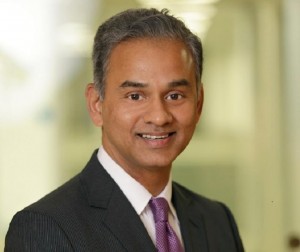As a part of our talent acquisition engagements, we ask our clients how they define “top talent” and how they would assess those traits in the interview process. Reflecting on the insightful comments we hear every day, we thought there would be great value in a new blog in which senior executives/thought leaders share their “Take on Talent.”
This is the tenth in a series of blogs/interviews with senior executives who are thought leaders in the areas of Talent Acquisition, Career Development and Leadership who will share their perspectives on this ever present question.

NV “Tiger” Tyagarajan, President & CEO, Genpact
Based in New York, Tiger is credited as one of the industry leaders who pioneered a new global business model and transformed a division of GE (formerly GE Capital International Services) into Genpact, a leading business process management and technology services company with $2.46 billion in annual revenues in 2015. The company delivers these services with a highly differentiated approach called Lean DigitalSM that helps clients drive disruptive transformation, leveraging digital and analytics.
In his role, Tiger spends a lot of his time with the C-Suite of large global corporations, helping them drive change globally and get more competitive in their industry.Tiger frequently writes and speaks about transformation, digital disruption, global talent issues, continuous skill development, and the importance of building a strong corporate culture. He is also passionate about diversity, serving on the board of the Center for Talent Innovation (CTI) in New York and as one of the founding members of the US chapter of the 30% Club, an organization of C-Suite executives, focused on achieving better gender balance at US companies and corporate boards. Tiger is also a member of the Wall Street Journal CEO Council.
Please share with us the top five characteristics (in priority order, first to fifth) of the most talented people you have encountered during your career, and your definition of each.
- For me, nothing tops the need to be Client-Centric, even Client-Obsessed! You need to be maniacal about serving your client, understanding your client’s business, putting their needs above and before all else, being their trusted advisor and partner, being totally transparent in your dealings with them and influencing their business decisions in order to make them grow and succeed. Nothing works or makes sense unless it begins from the client’s point of view. This is all-important and sacrosanct when one begins the process of attacking any area of improvement or opportunity. It is the way a leader has to think, it is the only way to successfully run a business. You have to know what your client wants and then constantly look for causes that, when attacked and addressed, will drive improvement. You exist because your client exists – never forget that.
- A close second, and a game-changer for me, is Curiosity. We need to find people with an insatiable curiosity. If you’re not curious, you’re dead. The business world is changing at lightning speed and we need to able to negotiate the twists and turns in order to stay relevant. You need to ask questions, never-ending questions. And that’s where a person’s Curiosity Quotient plays a huge role. We need to look for people with boundless, restless energy, who need to constantly question the universe and who need to know “Why?” “Why do some transactions or processes perform so well? Why do others not?” “Why is this client’s method of operating failing?” “Why is this client experiencing losses?” An analytical mindset that can cut through the clutter and see the patterns in oceans of data is an invaluable asset. I would say that the curiosity to learn through life is at the core of life itself!
- This brings me to the next thing we need to look for – Collaboration. This is critical behavior in today’s context. I strongly believe that given the complexities and dynamism of our environment, collaboration is going to be our true differentiator. Innovation and disruption can come from anywhere and anyone, so organizations should be well prepared to accept surprises. Growth will be guided by the way that we come together and partner each other, without being limited by our functional and business boundaries. This is the ONLY way we will be able to re-imagine impact for our clients and craft solutions at a completely different level!!
- What next? A Hunger in the Belly, a Fire in the Soul! Having an energized workforce actively engaged in the creation and sharing of information and knowledge is among the urgent requisites. We want people with an enormous ability and desire to learn. They need to have a burning passion for effective execution. They need to want to spend blood, sweat and tears. Forget about wordy resumes – what people know today is not likely to be equally relevant a year later. We need to constantly learn new things and acquire new skills to get ahead. These are times when we need to fail fast! So the real question is – are our people grabbing the new opportunities before them and making them work? Because if one is energetic and eager to learn – picking up specific skills is never a challenge. If you are not open to new ideas and are not able or willing to change as rapidly as the world around you, you will quickly become obsolete. In my experience, if you demonstrate a hunger to learn, a capability to learn and a desire to learn – you are going to be successful.
- And last but not least, I come to Competence. Many would presume this needed to be the first point, but really, in today’s day and age, with the levels of competitiveness and the pace of change, you have no alternative but to be competent. Depth in domain is irreplaceable. You need to know your clients’ businesses inside out. You need to partner them, advise them, pre-empt and predict their business problems, offer multiple solutions and options, grow their business and make sure they succeed. Building skills should not be an event. Rather it should be one of the primary threads of the organization’s fabric. For example, at Genpact our Employee Value Proposition is centered around ‘Learn. Grow. Succeed’, with training and development being a key pillar of our growth story. The upskilling efforts for our employees include not just building skillsets, but also toolsets and mindsets. Focusing on leadership, professional skills and domain, our L&D ecosystem offers an amazing range of programs with a mix of traditional and new-gen modules based on current needs.
How do you communicate these characteristics to your HR and senior management team?
No one person can or should ever do this. It needs to exist in a culture that believes in communicating, collaborating, sharing, maintaining an openness and transparency and expecting everyone to get on board, take part and take responsibility! At Genpact, this culture exists in our DNA and runs across the length and breadth of our organization. It is all-encompassing, it is omnipresent.
Joint sessions and collaborative meetings are held across leadership levels to decide, discuss and determine how we deal with situations, how we behave with each other, how we solve problems together, how we solve client problems, how we approach opportunities, how we make trade-offs and how we take risks. This is deeply entrenched in our company’s culture. Our Leadership teams are fully aligned to this way of thinking – and actively pass it down, up, sideways, throughout the organization. Culture has to spread in all directions and at all levels – in order to build up a juggernaut of people who are really going to make a difference.
How do you handle challenges to the existing culture by talent you have brought in?
True culture cannot be copied – or muddied. So if your differentiation is culture – a culture that is strong and unique and permeates your entire company – it’s a differentiation that’s built on your history, your legacy, who you are and how you got there. You know all of that, your employees know all of that – and then you teach your new talent all of that. And that proliferates even further, making your company – and your culture – even stronger. When this is the case it will always remain stable and retain its essential essence. Only that which complements it – discipline, hard work, passion, drive – will be further absorbed by the entry of new talent and new styles of operating.
That’s why you invest in building a strong team with strong leaders who become advocates of that culture and drive in consistently across the board. That’s why you invest in a strong governance structure with checks at various levels to ensure you’re on the right track. And this doesn’t happen in isolation, in terms of a “culture check”, because culture permeates everything – from the way you do performance appraisals, to bidding for business, to team meetings to financial report – everything! And it is strong leaders and teams and structures around each of these processes that is going to ensure there is consistency – and that your culture endures.




